SD › Seville › Hotels › Casa 1800 Sevilla Review
Updated: May 15, 2022
By Santorini Dave
Essentials
• Location: Calle Benalua, very close to Catedral de Sevilla.
• Hotel website: hotelcasa1800sevilla.com
• Hotel phone: +34 954 561 800
• Check prices for Casa 1800 Sevilla
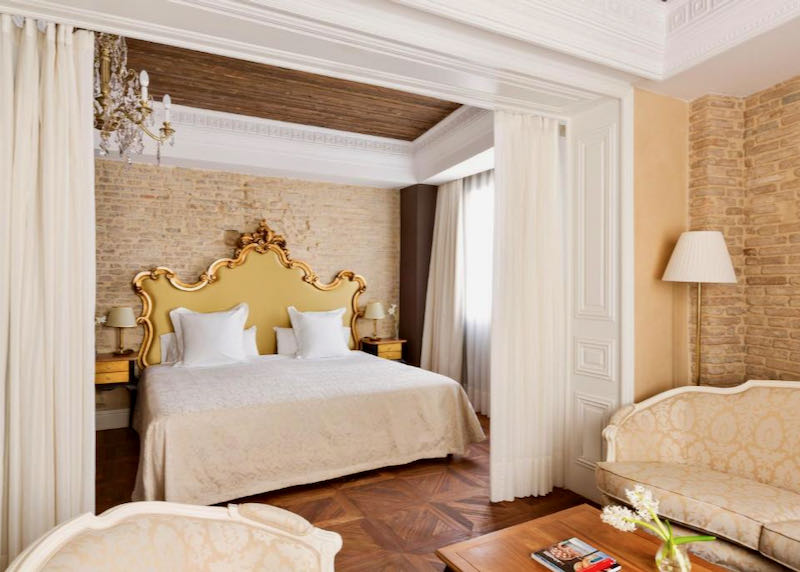
Housed in a historical building near the Cathedral, Casa 1800 Sevilla features opulent rooms with luxurious furnishing, decor, and mod-cons, and a superb rooftop terrace with a pool.
Casa 1800 Sevilla – Old-world luxury next to Seville’s cathedral.
Just steps from the cathedral and a number of excellent Barrio Santa Cruz restaurants, this luxurious three-story nineteenth-century mansion is all about location, location, location. The hotel is a perfect blend of historic charm and twenty-first-century comfort: the exposed brickwork, vintage floor tiles, and fin de siècle velvet sofas are paired with coffee makers. Other design features are impressive as well: the enormous central patio floods the interior with light, all the Premium rooms are individually decorated, and amenities include a rooftop pool and terrace with a splendid view of La Giralda bell tower. Personalized service is one of this intimate hotel’s best features.
See Also
- Best Hotels in Seville
- Best Hotels for Families in Seville
- Best Boutique Hotels in Seville
- Where to Stay in Seville
- Best Things to Do in Seville
Casa 1800 Sevilla – Location
- Address: Calle Benalua, 11.
- Nearest Subway/Tram: The nearest tram stop is Archivo de Indias, a 4-minute walk away. The nearest metro stop is Puerta de Jerez, a 5-minute stroll.
- Area: Very central. The hotel is located at the junction of 2 narrow streets in the warren of picturesque medieval lanes that make up its historical barrio, Santa Cruz, also known as La Judería, since it was the city’s Jewish quarters centuries ago. Numerous restaurants and tapas bars dot the streets around the hotel. Pretty much all of Seville’s top attractions are within easy walking distance: the cathedral, Real Alcázar palace, Museo de Flamenco, the Real Maestranza bullring, and the riverside Torre del Oro are all within a 10-minute walk from the hotel.
- How to Get There: From Seville Airport, it takes around 30 minutes on the airport bus (€4). The nearest stop to the hotel is Paseo Colón, near the Torre de Oro; from here, it’s less than 10 minutes’ walk to the hotel. If traveling long-distance by train in Spain, the Sevilla Santa Justa train station is less than 20 minutes’ walk from the hotel; alternatively, take bus #21 to the Menéndez Pelayo stop, just over 5 minutes’ walk through Barrio Santa Cruz to the hotel. Also possible to take a taxi (around €25-30) or Uber/Cabify.
- Private Transfer: We use and recommend Welcome Pickups car service. Booking through a private car service will cost only a bit more than a taxi – about €30 from Seville Airport – but can be worth it to avoid the long taxi queue and for the convenience of paying ahead.
- Handy to: Catedral de Sevilla, Real Alcázar, Hospital Los Venerables.
Casa 1800 Sevilla – The Basics
- Ages: Guests tend to be an international crowd, especially couples on a romantic or city break, and also families with children.
- View: Rooms have street views; the Deluxe Doubles with Terrace and Suite 1800 have views of the cathedral.
- Private Pools/Jacuzzis: Private terraces with jacuzzis in Suite 1800, Junior Suites, and Deluxe Rooms with Terrace (6 rooms in total).
- Laundry: Laundry service available (extra charge).
- Extras: Dedicated concierge service and 24-hour reception; all-day complimentary tea, coffee, and snacks from the guest pantry; large rooftop terrace with panoramic views and sun loungers; airport pickup and drop-off on request.
- When to Book: Book a couple of months in advance for the March-June, September, and October high seasons, plus the Christmas/New Year period. Book at least 4 months in advance for Easter.
- How to Book: Booking.com will have the best rates.
- Phone: +34 954 561 800
- Email: info@hotelcasa1800.com
- Website: hotelcasa1800sevilla.com
Casa 1800 Sevilla – Amenities
- Pool: Rooftop pool with views of the cathedral.
- Spa: No spa but in-room massages and treatments arranged on request.
- Fitness Center: No fitness center.
- For Disabled Guests: There is one specially adapted room on the ground floor.
- For Families: No family rooms per se, but baby cots are available free of charge and extra beds can be accommodated in the larger rooms and suites (free of charge for kids under the age of 9 and €45 per extra bed for older kids). Babysitting arranged on request and kids get a gift pack with crayons on arrival.
Casa 1800 Sevilla – Food and Drink
- Restaurant: No restaurant, though there are homemade chocolate cookies for guests. The staff is happy to recommend good restaurants within a few minutes’ walk from the hotel.
- Lounge/Bar: No bar, but numerous tapas bars in the hotel’s vicinity.
- Breakfast: The excellent breakfast buffet spread costs €13 per person and includes top quality cold cuts, fruits, churros with hot chocolate, plus hot dishes such as scrambled eggs with bacon. Served 8-10.30am in the atrium or in the guests’ rooms.
- Room Service: No room service.
Casa 1800 Sevilla – Rooms
- Room Types: Premium Room • Premium Room with Patio • Deluxe Premium Room • Junior Suite with Jacuzzi • Deluxe Room with Terrace and Jacuzzi • Suite 1800 with Jacuzzi • List of all Rooms
- Smoking Rooms: Hotel Casa 1800 is 100% smoke-free.
- Best Room: The duplex Suite 1800 is the grandest and most spacious of the rooms, with a private rooftop terrace with jacuzzi, reading room, original 19th-century furnishings, and elegant decor – all soothing creams and dark wood.
- For Families: No family rooms per se, but the larger ones can accommodate extra beds.
Casa 1800 Sevilla – Local Transport
- Walking: Central Seville is compact and wonderfully walkable, and wandering the tiny medieval lanes of Barrio Santa Cruz, the neighborhoods of Centro and Feria, and the wide boulevard and riverfront promenade that stretches along the Guadalquivir River is great fun. Most main sights can be easily reached on foot from the hotel – the cathedral is a 3-minute stroll, the royal palace is a 4-minute walk, and even attractions such as the Real Maestranza bullring and the Museo de Bellas Artes are a 10-15 minute stroll away.
- Metro/Tram: Public transport is of limited use to most visitors. The metro is only useful to go 1 stop across the river to the Triana neighborhood, or else into the eastern suburbs. The electric tram line runs between the San Bernardo train station in eastern Seville to the historical center, culminating at Plaza Nueva, a short walk from the hotel.
- Taxis, Uber, & Cabify: A taxi from the airport is around €21-30; Uber and Cabify charge around €18-27, depending on type of vehicle. Using taxis/ride-sharing services to get around central Seville is not required due to the ease and convenience of walking; the minimum fare is €3.65.
Casa 1800 Sevilla – What’s Nearby?
Recommended Nearby Tours
- Pancho Tours – Run by travelers, for travelers, these enthusiastic guides run free walking tours of Seville that last around 2.5 hours and take in the main historic sites. Tips are greatly appreciated. Departure point: Puerta Jerez.
- Bajabikes – Highly recommended 3-hour cycling tours of the city that cover the main sights on both sides of the river, from the royal palace and cathedral to the Torre de Oro and Triana bridge. E-bikes available at extra charge. Departure point: Calle Santas Patronas 29.
- Apie Experiencias Turisticas Guiadas – Three different small-group guided tours that focus on the Real Alcázar, cathedral, Giralda, and Barrio Santa Cruz and its Jewish history; also longer tapas tours. Knowledgeable, engaging guides; private tours also available. Departure point: Plaza del Triunfo.
Best Nearby Tapas Bars & Restaurants
- L’Oca Giuliva – One of Seville’s most authentic Italian places, this pizzeria cooks up superlative Neapolitan pizza with toppings imported from the mother country. Inexpensive and popular with families.
- Torres y García – This hip bistro combines industrial-rustic decor with creative ‘rustic’ cuisine (think pig trotter casserole, beef tenderloin with mash, cod gratin). The restaurant is also justifiably famous among locals for its woodfired pizzas.
- Casa Morales – Run by the Morales family since 1850, this classic Sevillian bar is a great place for a glass of wine, house vermouth, or sherry and tapas, with customers sitting surrounded by enormous clay tinajas (jugs). A list of full-sized raciones is chalked on one of the jugs, and there’s an extensive tapas menu, ranging from charcuterie and cheese to tiny montaditos (sandwiches).
- Taberna del Alabardero – The seasonal menu at one of Seville’s finest upscale restaurants focuses on traditional dishes with a contemporary touch, such as crispy suckling pig with red cabbage and smoked venison loin. The bistro downstairs is less formal; dress up for the restaurant. The wine list features rare Spanish vintages. Bookings essential.
- Sahumo – Meat is the star of the show here – from the tender beef entrecote and lamb with wood-grilled vegetables to presa Ibérica with mojo picón (marbled pork shoulder with spicy olive oil, garlic, and paprika sauce). Tapas tend to be a little pricier than in many other bars, but more varied and imaginative, too.
- Ovejas Negras Tapas – A stone’s throw from the cathedral, this contemporary tapas bar combines vibrant, punchy, and pop art-y decor with interesting international flavors. Their specialties include the risottazzo (an expertly prepared mushroom risotto), tuna tartar, and some of the best gourmet burgers in town. It’s a casual, buzzy, mid-priced place.
- Vinería San Telmo – The tapas bar attached to this venerable restaurant features an extensive menu of Andalusian and Spanish wines by the glass as well as a good selection of sherries. The nibbles are carefully chosen by the owners to complement the wines.
- Bar Baratillo – Around the corner from the bull ring, bullfighting is the theme at this tapas bar. Expect mounted bulls’ heads on the stone walls and an extensive menu of traditional, meat-heavy tapas such as braised oxtail and slow-cooked beef cheek. Good selection of wine and beer, mixed local and international crowd, and the odd matador.
- Abantal – Just outside Barrio Santa Cruz, at the city’s only Michelin-starred restaurant, Chef Julio Fernández makes the most of seasonal produce. Expect the likes of wild mushrooms with truffled egg yolk, red tuna cheek with pepper jelly, and beef sirloin with leek and goat’s cheese gratin. The tasting menu is ideal for a special occasion. Elegant and romantic; reservations a must.
- Bar Postiguillo – Classic Andalusian stews, charcuterie, and meat-heavy tapas (oxtail croquettes, slow-cooked pig’s cheek) served beneath bull’s heads mounted on walls at this corral-themed restaurant. Popular with locals and visitors alike.
- Arco Tapas – Contemporary tapas bar specializing in international classics such as tuna tataki and beef tartar, as well as Mediterranean bites such as cannelloni with spinach and pine nuts and squid-ink rice. Casual, inexpensive.
- Sibuya – Minimalist sushi spot with daily sashimi specials prepared from whatever’s fresh and in season at the market, as well as bao buns and Korean-style fried chicken. Busy at lunchtime, good for a quick bite.
Nearby Bars and Breweries
- Bodega Santa Cruz – A beloved local institution, this old-school, standing room only tapas bar with some outdoor tables to lean on is all about traditional Andalusian bites. Come for the charcuterie, cheese, and salmorejo (thick, savory gazpacho), along with a cold beer or glass of local wine.
- Casa Moreno – Head for the tiny room at the back of this abacería (neighborhood grocery store) to reach the very local, standing-only tapas bar decked out with bullfighting posters. Go for hot tapas – peppers stuffed with morcilla, artichokes stuffed with seafood, and fábada (hearty bean and chorizo stew) at lunchtime, and tiny montaditos (sandwiches) the rest of the day.
- Taberna Álvaro Peregil – Serving vino de naranja (white wine macerated with orange peel) since 1904, this tiny, rustic bar is frequented by dedicated regulars and is standing room only. Good selection of Andalusian wines, plus strawberry-infused fortified wine.
- The Second Room – This thimble-sized bar specializes in an extensive range of well-crafted classic cocktails, ranging from superlative mojitos to strong espresso martinis. Prop up the bar or take it out onto the tiny terrace.
- La Vermutera de Sevilla – Old-school vermouth store and bar with red, white, and rose vermouths from all over Spain, along with tapas that compliment the tipples such as smoked sardine toast and pickled mussels. One for aficionados, or else a great place to get introduced to the joys of vermouth.
- El Garlochí – The owners of this kitschy bar opted for a Semana Santa theme and decided to run with it a few miles. Come here for the signature Sangre de Cristo (Blood of Christ) cocktail, served in the incense-scented, religious icon-bedecked surrounds.
- La Jerónima – This boho cultural space/craft beer bar doubles as a bookstore selling titles by Spanish authors as well as art, accessories, and clothing by independent local designers. There are 4 regularly rotating beers on tap as well as plenty more bottled options.
- Maquila – Apart from super-fresh beer from their own microbrewery at the back, Seville’s first real brewpub serves a rotating range of 6 Spanish and international beers on tap. A firm favorite with local beer aficionados, with hipster vibes.
- Hops & Dreams – The brainchild of 2 beer-loving Sevillians, Hops & Dreams is a chilled-out spot down a little side street off La Alameda, complete with a retro arcade machine and 8 rotating beers on tap from Spain, the UK, and beyond. There are some terrific tapas here as well.
- Bier Kraft – Pared-down industrial chic is combined with red velvet and blue leather banquettes at this stylish American-run bar. Apart from a hundred or so bottled brews available at the attached bottle shop, there’s a healthy selection of beers on tap, including local Rio Azul, Barcelona’s Edge Brewing, and from a few US breweries. Buzzy, good mix of locals and visitors.
Best Nearby Cafes
- Jester – Beautiful breakfast bowls, freshly baked pastries, specialty coffee, filled bagels, smoothies, and juices. Outdoor seating.
- Bar El Comercio – This tiny, tiled, family-run ham-hung bodega doubles as a coffee bar and is one of the best places in town for a traditional chocolate con churros breakfast. The drinking chocolate is thick and rich, while the churros (deep-fried dough tubes) are fresh and piping hot.
- Torch Coffee Roasters – Right near the Torre del Oro, this roastery is run by 2 American sisters and is very community-focused. Come for the carefully-sourced, seasonal coffees, and while away some time in this bright and airy space over brunch.
Nearby Shopping & Cool Shops
- Productos de la Sierra – This gourmet ingredient shop is a great place to pick up local charcuterie, award-winning olive oil, artisanal pates, cheese, and Andalusian wines and craft beer.
- Padilla Crespo Ala Ancha (Calle Adriano 16) – Beautiful leather bags, accessories, and wide-brimmed hats sold here kit out revelers during the Feria de Avril. Also find espadrilles, hand-painted Andalusian fans, and locally made sombreros here.
- Artesanía Textil – Come here for hand-embroidered shawls that Sevillian ladies wear to weddings, bullfights, or even with flamenco dresses. They make terrific gifts and the price varies widely, depending on the size and whether it’s silk or rayon, and handmade or machine-made.
- Isadora – Located in the Soho Benita area (5 shopping streets located between Las Setas de Sevilla and Plaza Alfalfa), this store is very popular with local fashionistas. Come here for shoes and accessories by local designers, plus a wealth of women’s vintage clothing.
- Boutique La Folie – This ultra-modern, minimalist boutique stocks smart clothing and one-of-a-kind accessories by local up-and-coming designers. Reasonably priced for the quality involved.
- Un Gato en Bicicleta – This arty independent bookstore doubles as a gallery and a ceramics studio. The book selection is particularly strong on fashion, architecture, and cinema, and customers can also purchase local art, take part in ceramics classes, or just come to the adjoining café for a coffee.
- La Seta Coqueta – This concept/vintage store is all about quirky, affordable women’s fashion, with pieces that are not available in the high street chains. Come here for stylish streetwear and accessories.
- Ceramicas Sevilla 1952 – Beautiful, locally hand-made ceramic tiles and dishes – both decorative and functional.
- Juan Foronda – Hand-embroidered shawls, mantilla headdresses, fans, castanets, and other hand-crafted Andalusian accessories.
- Papelería Ferrer – Gorgeous stationary shop whose origins date back to 1856, selling fine fountain pens, quills, and top-shelf writing paper, as well as collectors’ items in the form of antique globes and sealing wax.
Nearby Attractions
- Seville Cathedral & La Giralda bell tower – Seville’s cathedral is the largest Gothic church in the world. Highlights include works by Zurbarán and Murillo in the art pavilion, the largest altarpiece ever made, and the magnificent tomb of Christopher Columbus to the right of the high altar. In the southeast corner, the Treasury displays priceless jeweled pieces, while the sacristy is decorated with intricate Plateresque silverwork. Tickets include entry to the 330-feet Giralda (bell tower) that used to be the minaret; the city views from the top are wonderful. Exit through the Court of the Orange Trees.
- Real Alcázar – The home of Moorish rulers in the 10th century, this enormous UNESCO World Heritage palace complex is a stunning mix of Islamic and Christian elements. Don’t miss the Admiral’s Hall where Columbus reported back to Queen Isabel about his New World discoveries. Other highlights include the Courtyard of the Maidens with its rectangular pool, the Moorish dome in the king’s throne room, the Courtyard of the Dolls with its Mudejar arches and pool, and the vast palace gardens. To skip the lines, book the visit time slot online in advance.
- Archivo de Indias – Housed inside a stunning 16th-century former merchants’ exchange across the street from the Alcázar, the archive of the Spanish Empire houses hugely valuable historical documents that illustrate the conquest of the New World, including the diary of Christopher Columbus. Head up the grand marble staircase to the vaulted galleries to check out the antique maps of different corners of the New World.
- Centro de Interpretación Judería de Sevilla – This small museum inside an old Sephardic house is dedicated to Seville’s lost Jewish community that suffered a brutal pogrom in 1391. On display are various artifacts, and the museum offers guided walks of Seville’s Jewish sites. Pick up maps of Santa Cruz with formerly Jewish sites marked on them, including 3 synagogues converted into churches.
- Hospital de los Venerables – This 17th-century former hospital turned art museum features a painting gallery dedicated to Diego Velásquez, one of Spain’s greatest painters (from Seville). Notable works by other artists include The Penitent St Peter by Murillo and Friar Peter of Oña by Zurbarán. The Baroque church, attached to the hospital, is well worth a look for the trompe l’oeil and the frescoes by Valdés Leal.
- Museo del Baile Flamenco – Created by the renowned Sevillian flamenco dancer Cristina Hoyos, this museum teaches all about the passionate dance that’s synonymous with Andalusia. Check out the flamenco costumes, fans, shawls, and a large collection of posters depicting flamenco greats from bygone times, and don’t miss the screening room. Nightly live performances of flamenco take place here.
- Plaza de Toros La Maestranza – In Andalusia, bullfighting remains a venerable part of Spanish culture. The 14,000-seat Maestranza – one of the oldest (1761) bullrings in the country – holds bullfights at Easter, on Sundays in May and June, and in late September. The corrida de toros – a deadly spectacle in 3 parts and featuring big-name matadors – sells out days in advance; ticket prices depend on the proximity to the sand and whether in the sun or shade.
- Museo Taurino – Even if not attending a bullfight, it’s well worth visiting Seville’s venerable bullring and attached museum for a guided tour. Visitors get to see numerous etchings, lithographs, prints, paintings, and engravings of bulls and bullfighting. The most striking exhibits include the mounted heads of bulls and the trajes de luz (suits of light) worn by legendary matadors.
- Hospital de la Caridad – This historic hospital for the poor was founded in the 17th century by the playboy nobleman Don Miguel de Mañara. The entrance leads into a courtyard with Tuscan columns, Delft tile-work from the Netherlands, and marble fountain sculptures from Genoa, Italy. The highlight is the Baroque chapel, decorated with powerful paintings on the theme of mortality by Valdés Leal.
- Torre de Oro – Overlooking the Guadalquivir River, this 13th-century military tower was once part of the city’s fortifications and marked the starting and ending point for all the shipping to the New World. Inside there’s a naval museum; highlights include scale models of all 3 of Columbus’s ships. Climb to the top for excellent views of the city and the river.
Nearby Markets or Grocery Stores
- Carrefour Express (Calle Harinas) – Small grocery store in El Arenal.
- Mercado de la Encarnación – This terrific produce market beneath the Metropol Parasol (giant wooden mushrooms) is the best bet in central Seville for edible goods.
Casa 1800 Sevilla – The Hotel
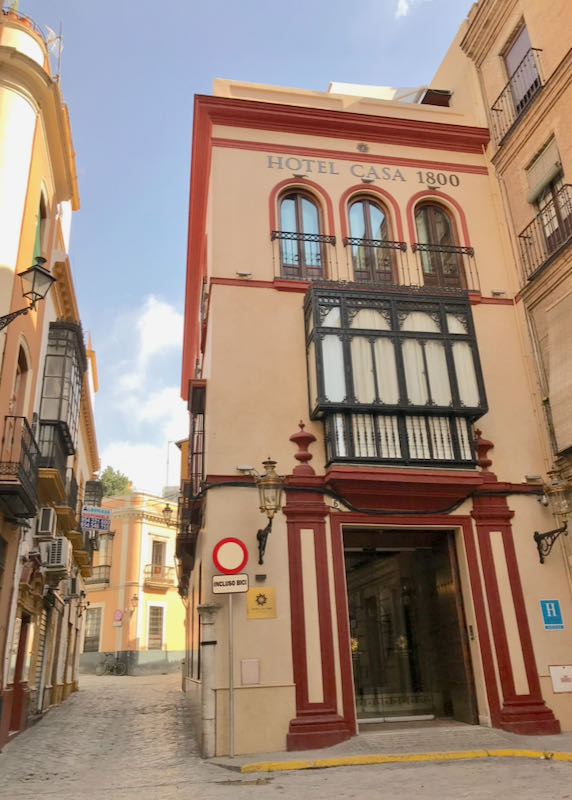
Casa 1800 Sevilla sits in one of the tiny lanes in Seville’s Barrio Santa Cruz, around the corner from the city’s famous cathedral.
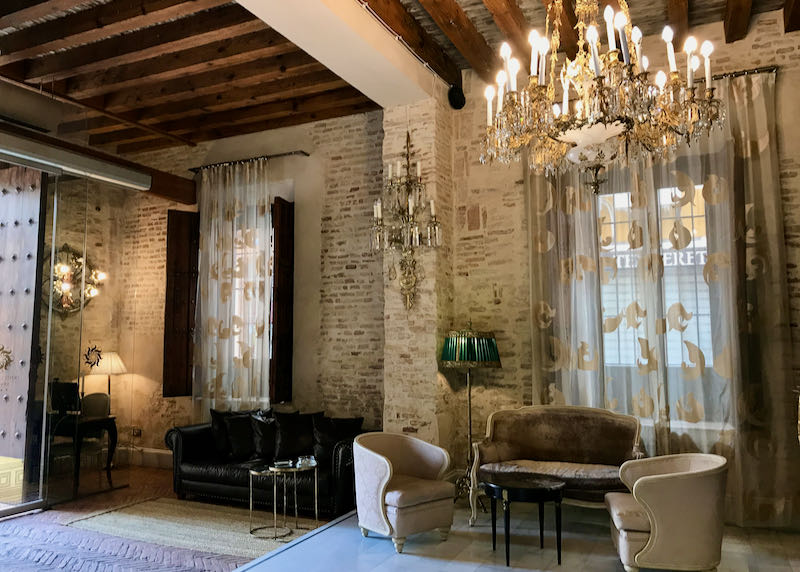
The lobby sets the tone for the rest of the hotel, with its sturdy doors, heavy wooden beams, exposed bricks, and chandeliers.
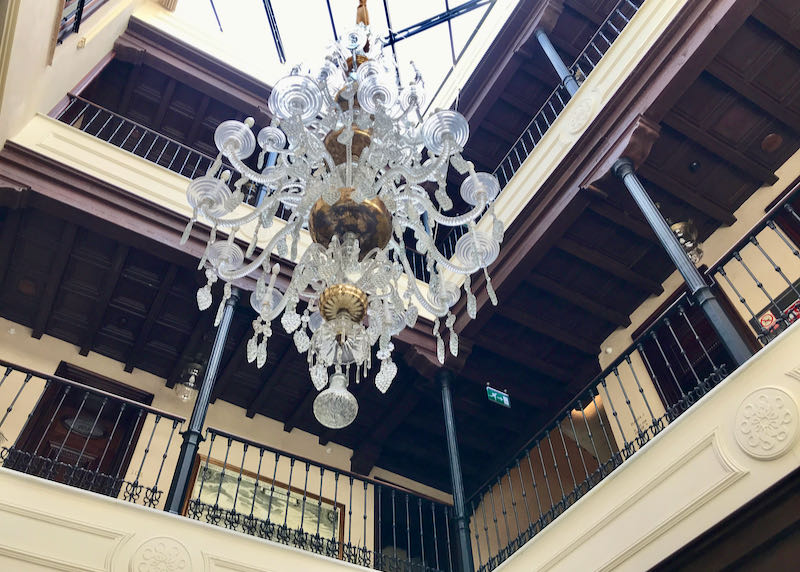
From the lobby, the rooms are arranged around a glassed-over atrium.
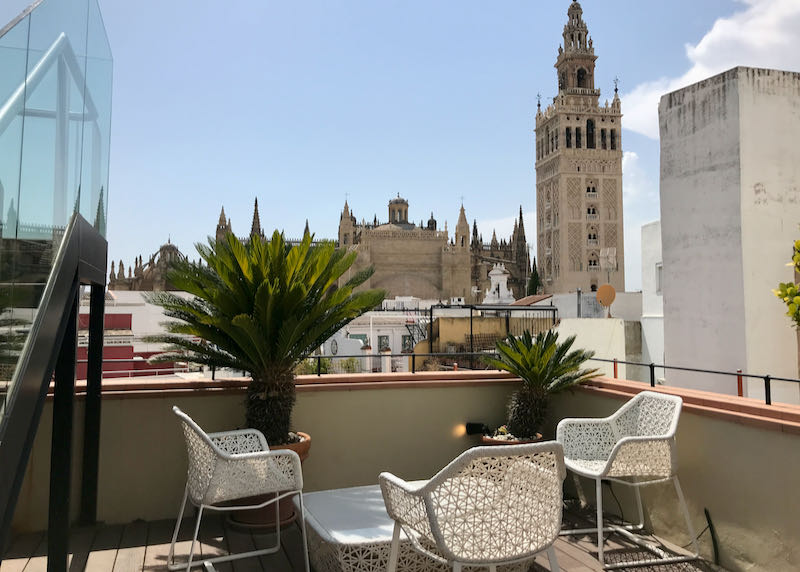
Common spaces include the wonderful rooftop terrace with views of the cathedral and the Alcázar,…
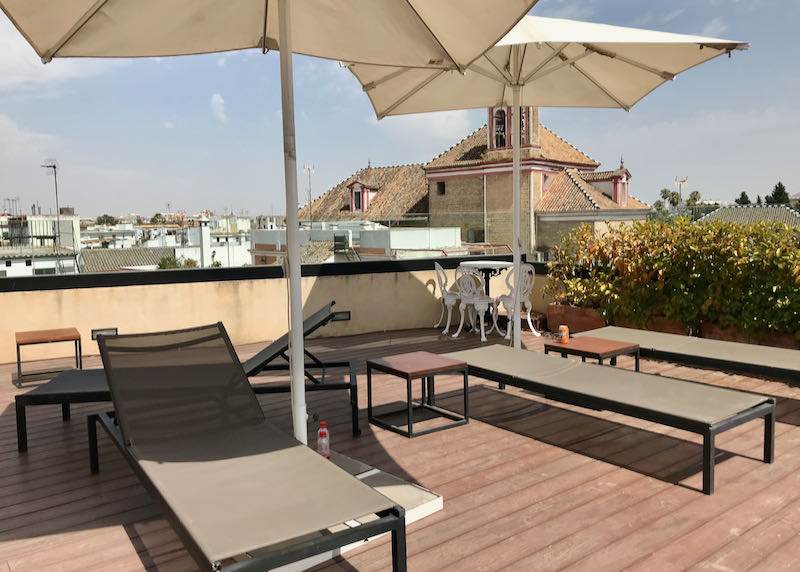
…sunbathing area with sun loungers,…
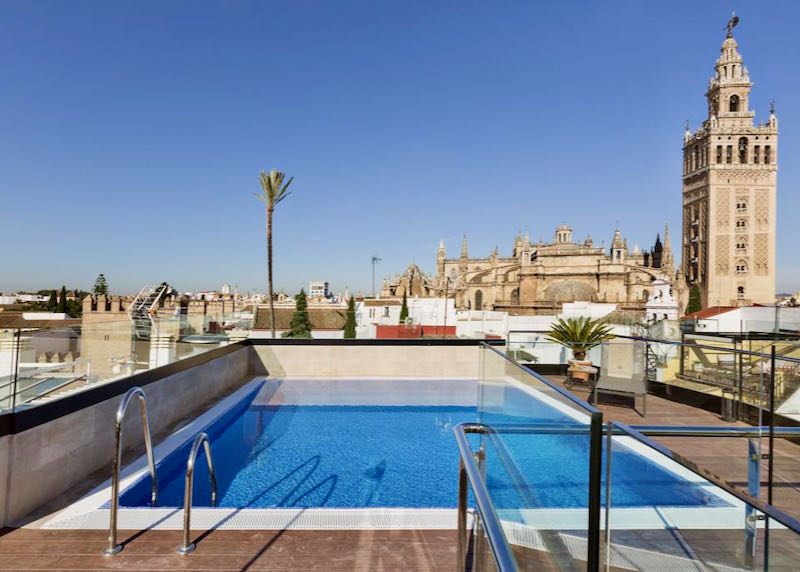
…and a rooftop pool.
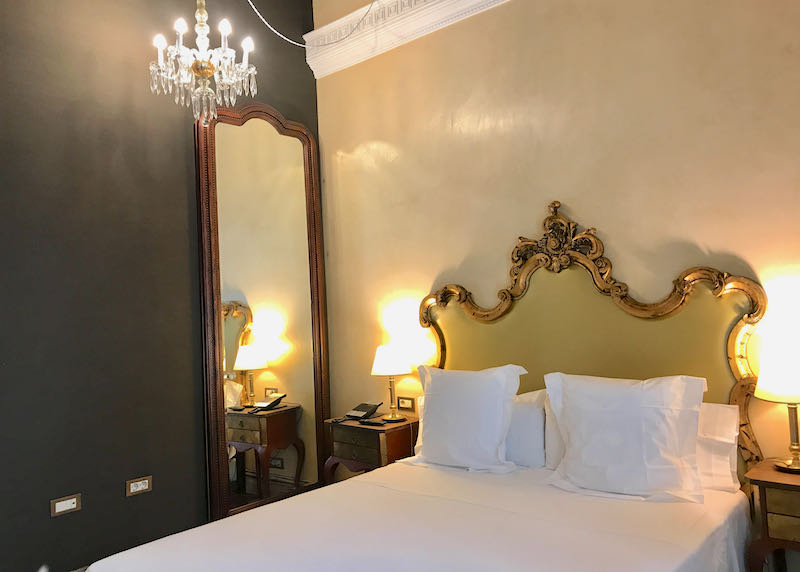
Premium rooms are on the cozy side (though mid-sized for rooms in Seville in the same price category), and with plenty of character: ornate headboards, heavy wooden beams, chandeliers, and custom-made wardrobes.
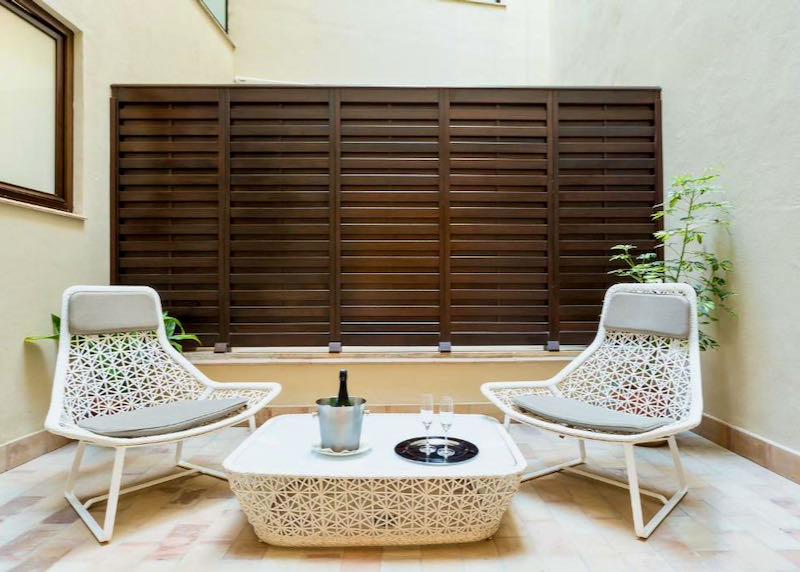
Some Premium rooms come with private patios.
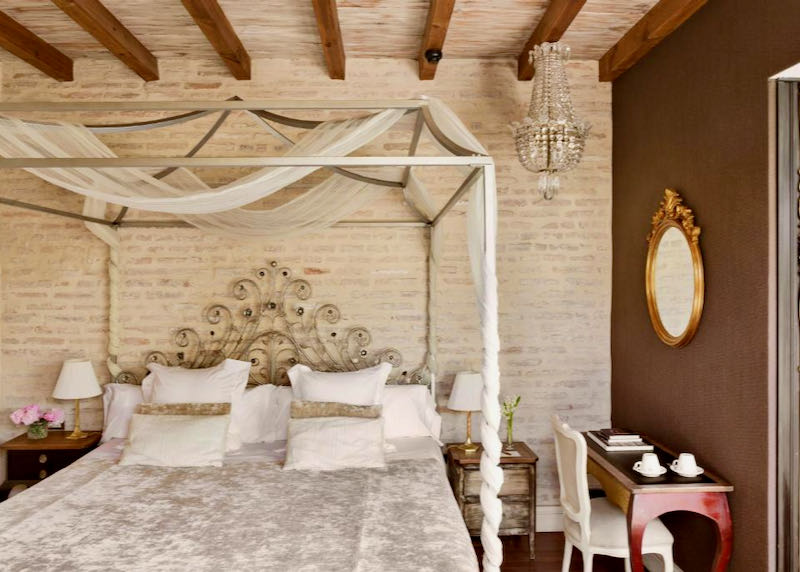
The hotel has 6 rooms with al fresco jacuzzis. To save some money, opt for the Deluxe Room…
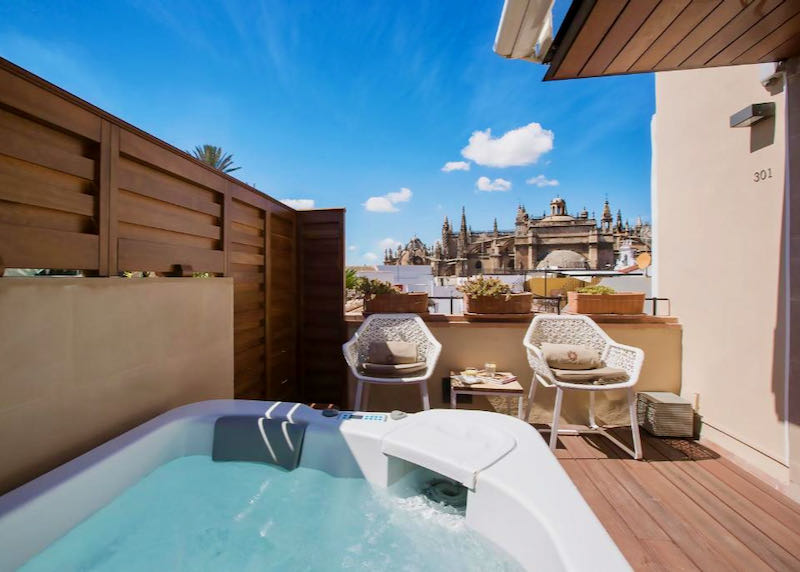
…which is mid-sized, but with the big perk of its own private terrace and jacuzzi.
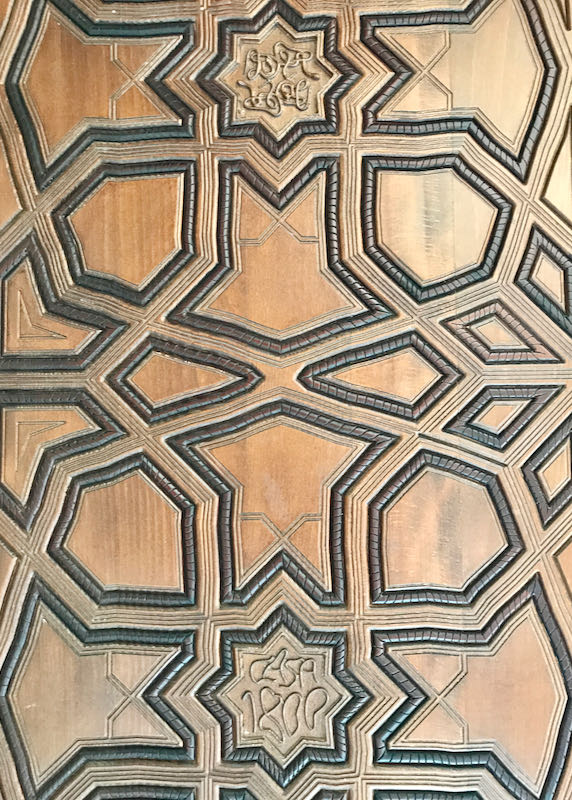
Throughout the hotel are classic Andalusian design features, from the Moorish-inspired door pattern…
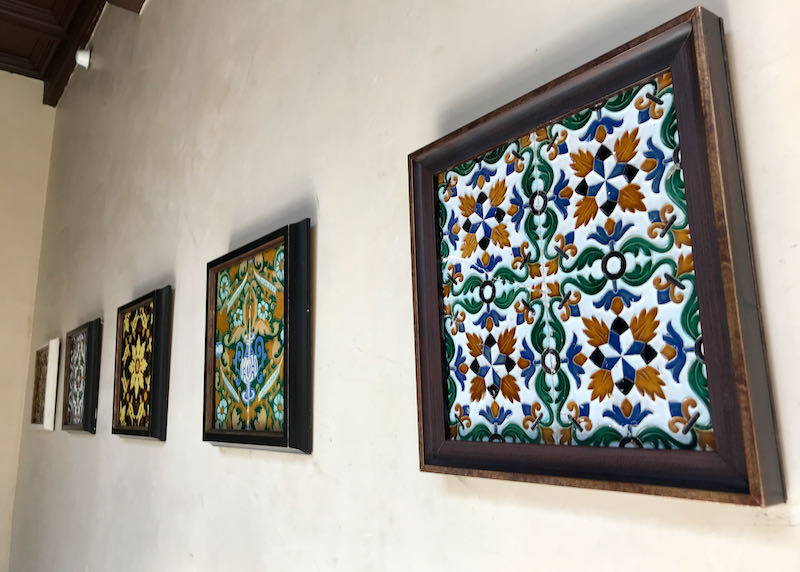
…to the locally made tiles.
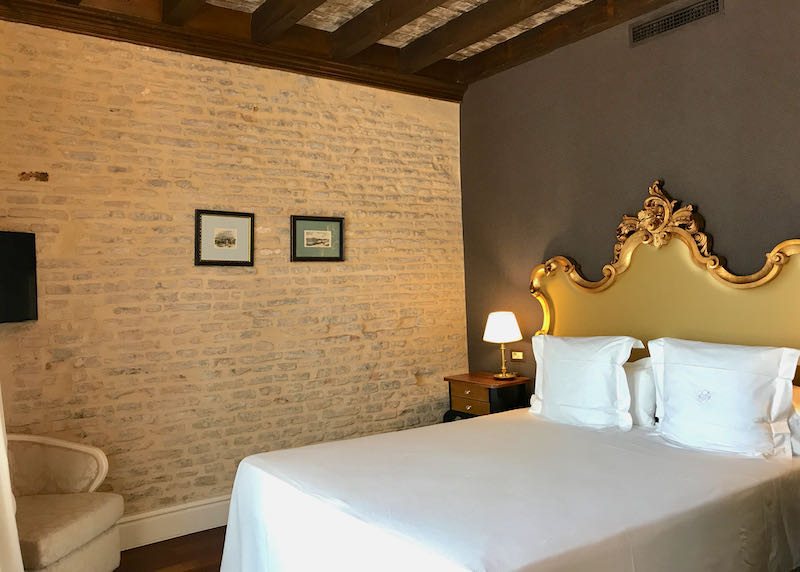
The Deluxe Premium Rooms are a big step up from the 2 cheaper room categories in terms of room size; many have partially separate bedroom areas,…
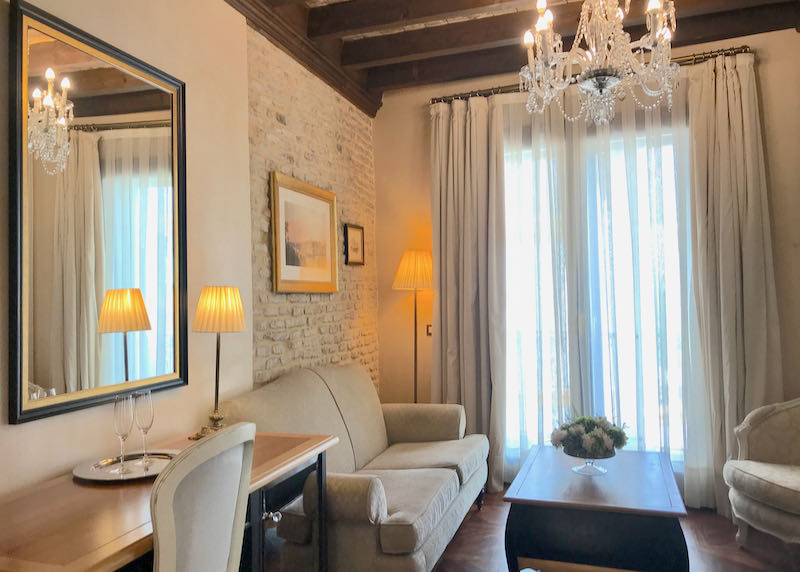
…spacious living areas,…
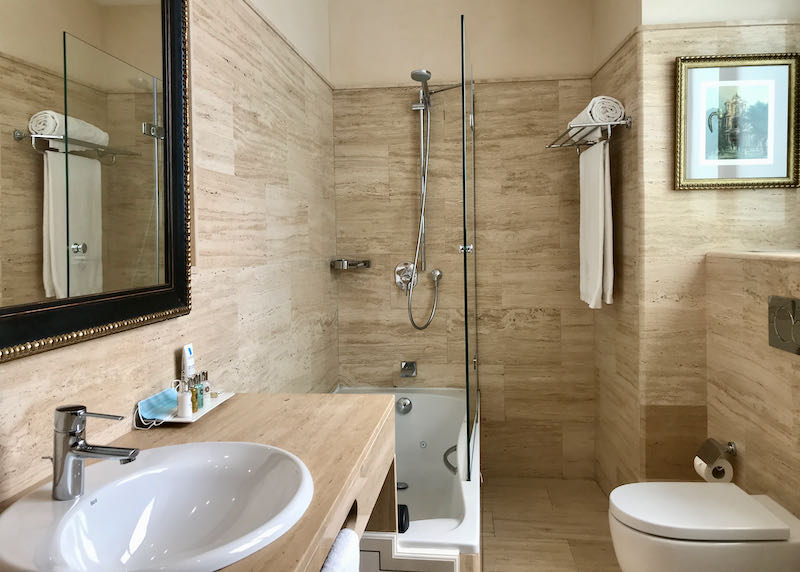
…and generously-sized bathrooms with shower and bath combos.
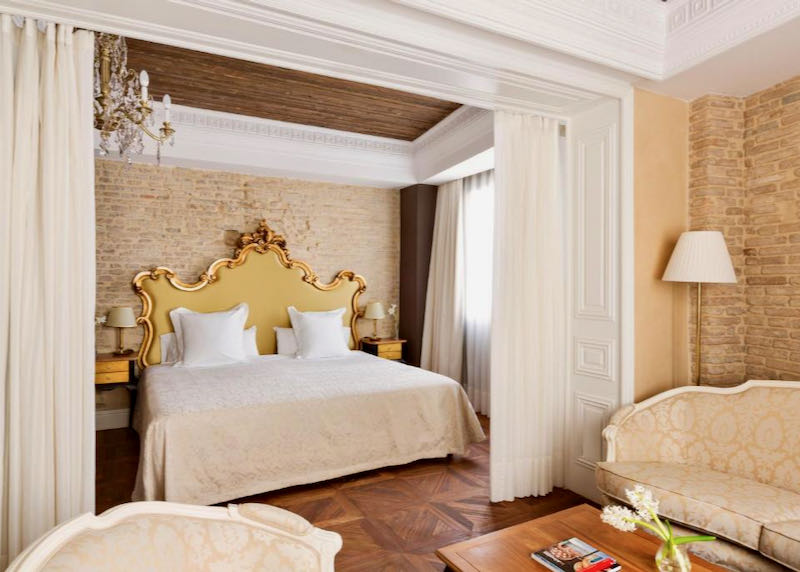
The Junior Suites are even more generously proportioned, located higher up in the hotel and with private jacuzzis on their terraces.
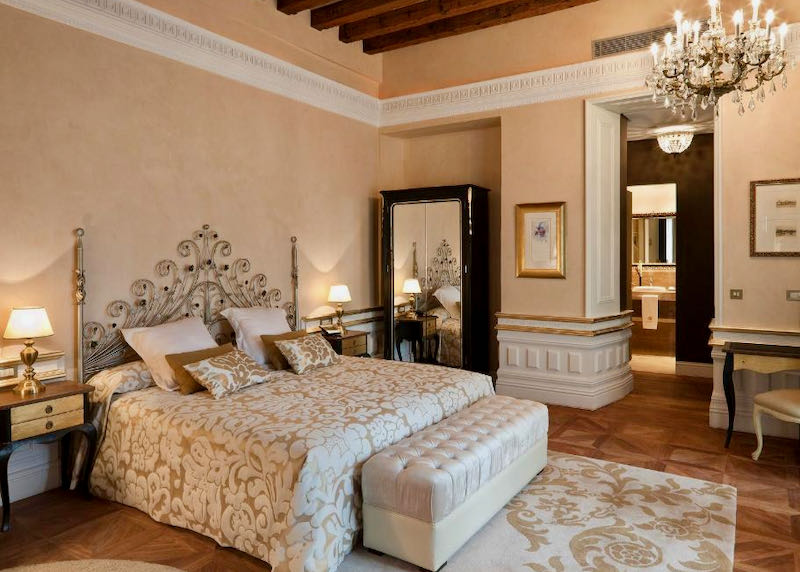
The hotel’s most splendid room is the Suite 1800. It’s a split-level room with plenty of natural light, high ceilings…
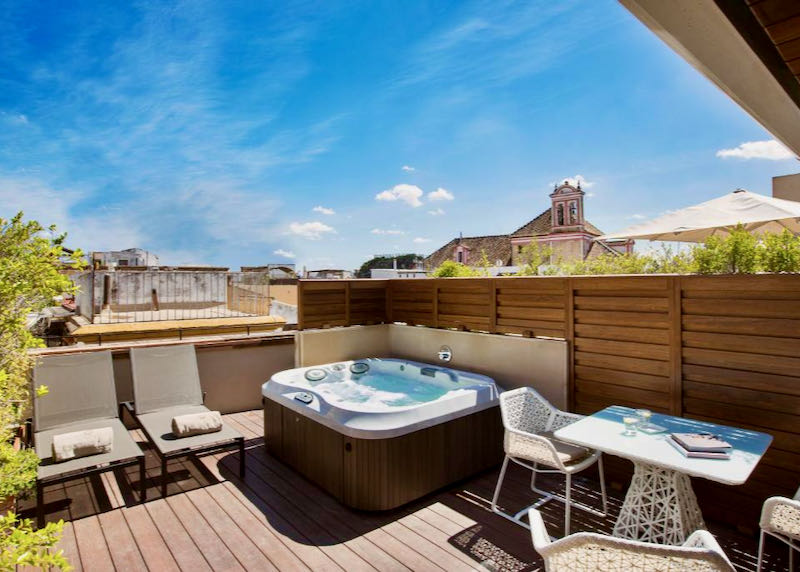
…and a private terrace with a jacuzzi, accessed via a small reading room.
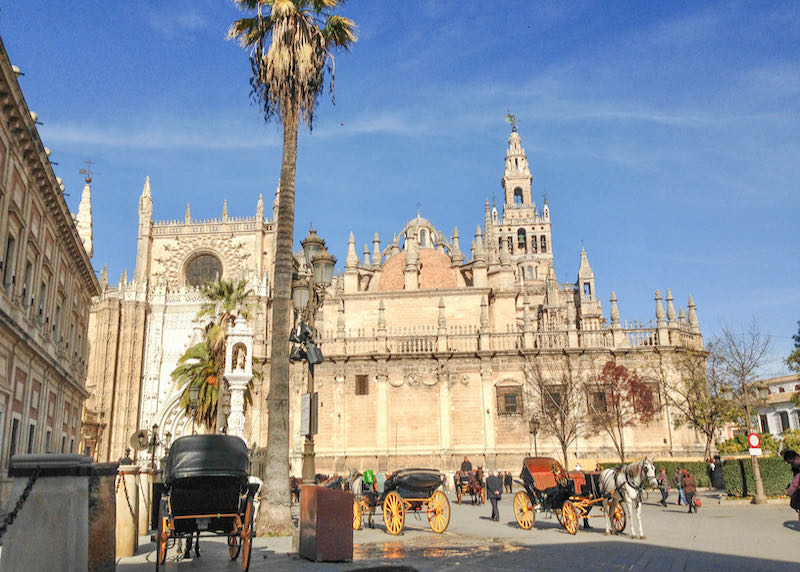
Come out of the hotel, walk a block west, and find the Plaza del Triunfo in front of the cathedral.

South of the plaza is the Real Alcázar, the millennia-old palace complex that was once home to Moorish rulers, and one of Seville’s unmissable attractions. This is one of its elegant courtyards.
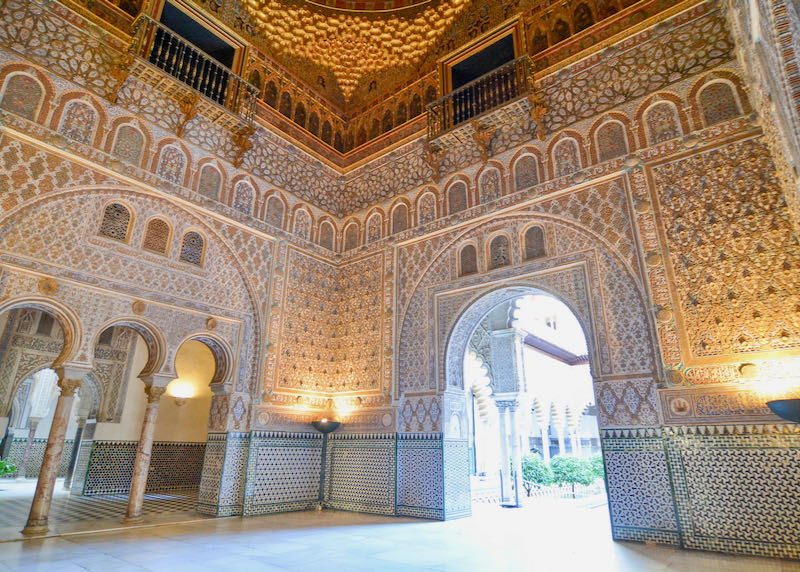
This is the king’s throne room.
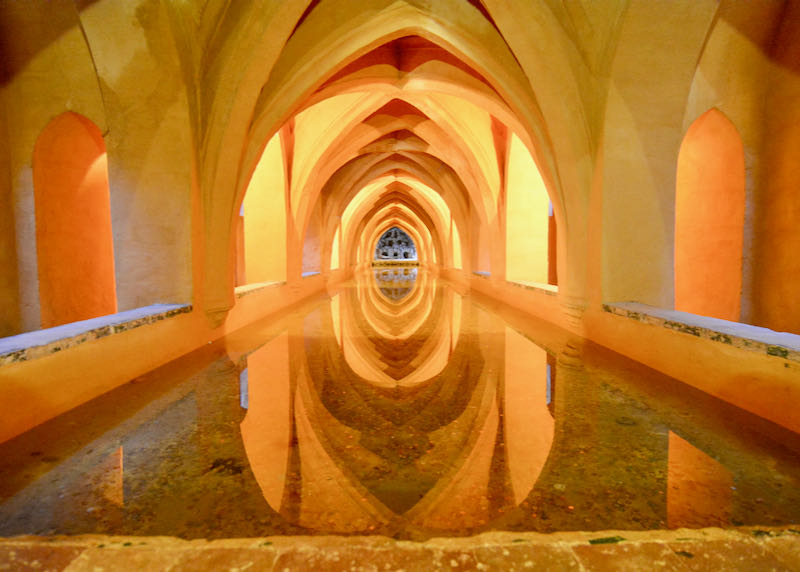
And this is the subterranean pool near the palace gardens.

Take the tiny lane to the left of the entrance to the Real Alcázar, and then another left past this small plaza…
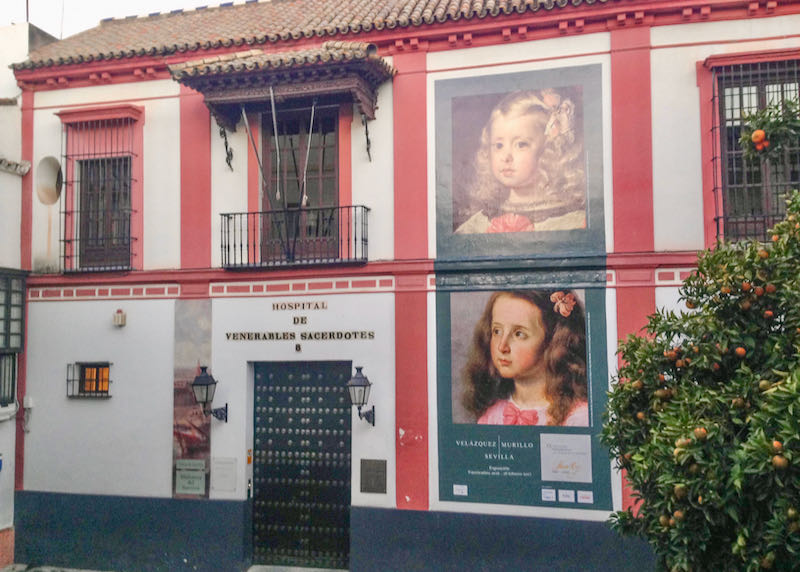
…to reach the Hospital de los Venerables, a former 17th-century hospital turned fine art museum.
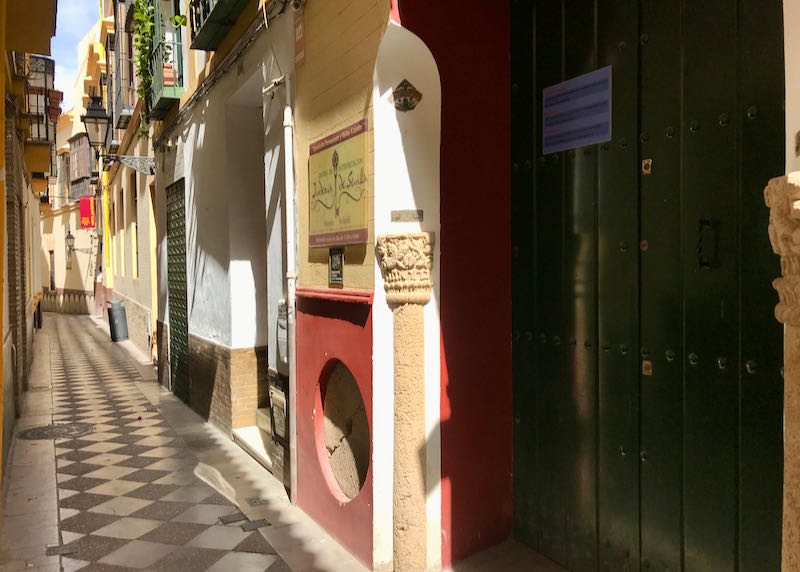
Follow the lane as it winds its way north and then take a right into Calle Ximenez de Enciso, past the Centro de Interpretación Judería de Sevilla, a small museum dedicated to the history of Seville’s lost Sephardic Jewish community.
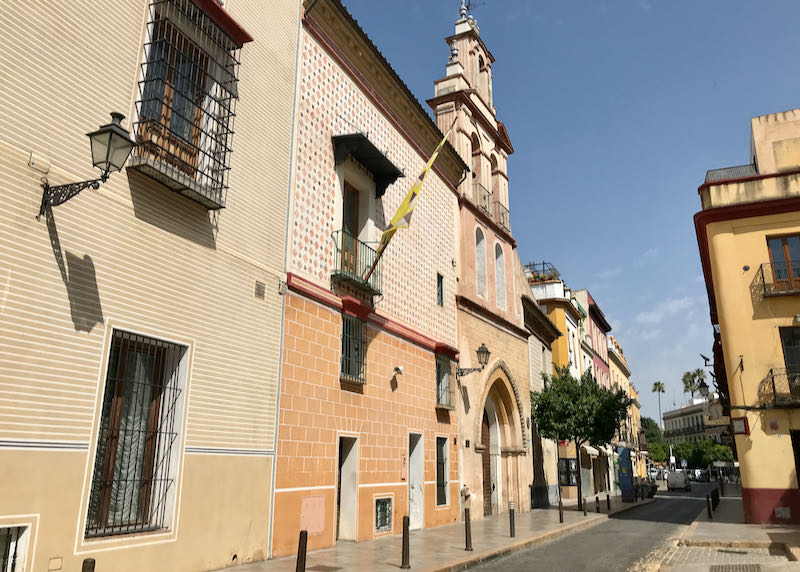
Then turn right into Calle Santa Maria La Blanca…
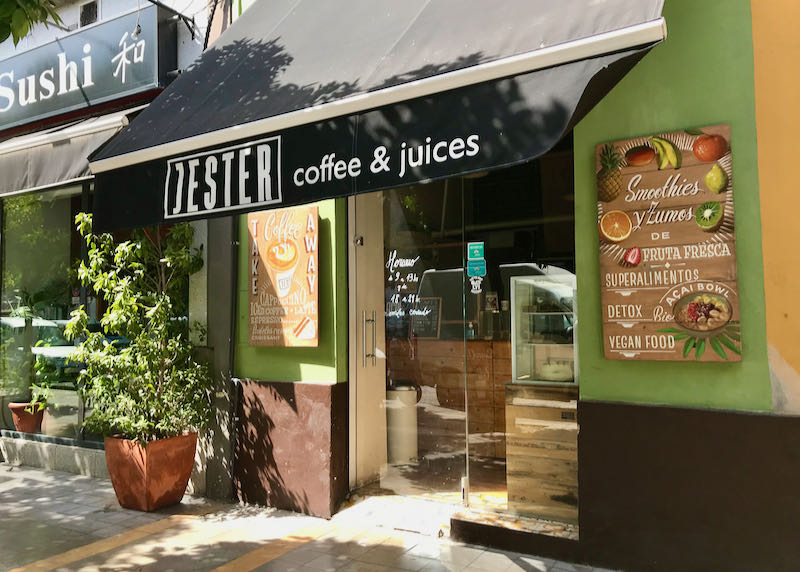
…to reach the Jester café, an excellent breakfast/brunch spot for a filled bagel, coffee, or a smoothie.
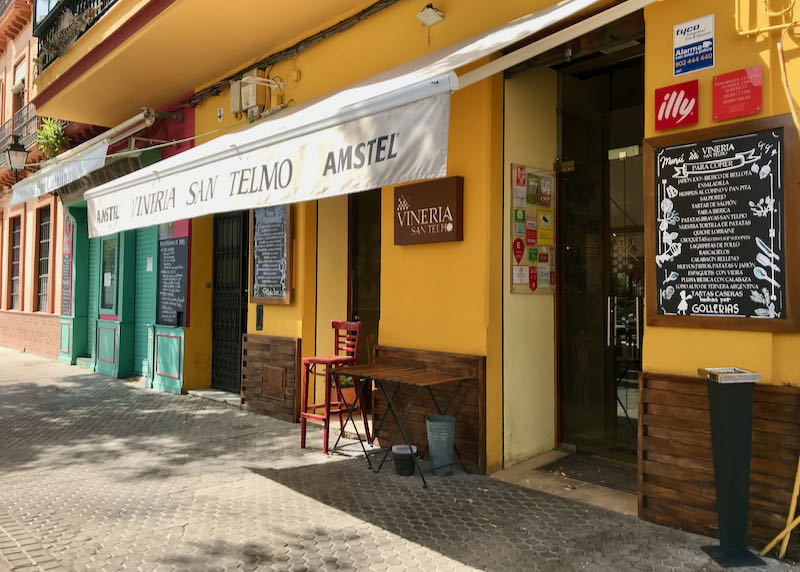
A block southwest, on a small parallel street is Vinería San Telmo, a venerable restaurant and tapas bar serving Andalusian classics as well as regional wines by the glass.

Just beyond the restaurant are the Jardines de Murillo, the gardens adjacent to the vast palace gardens.
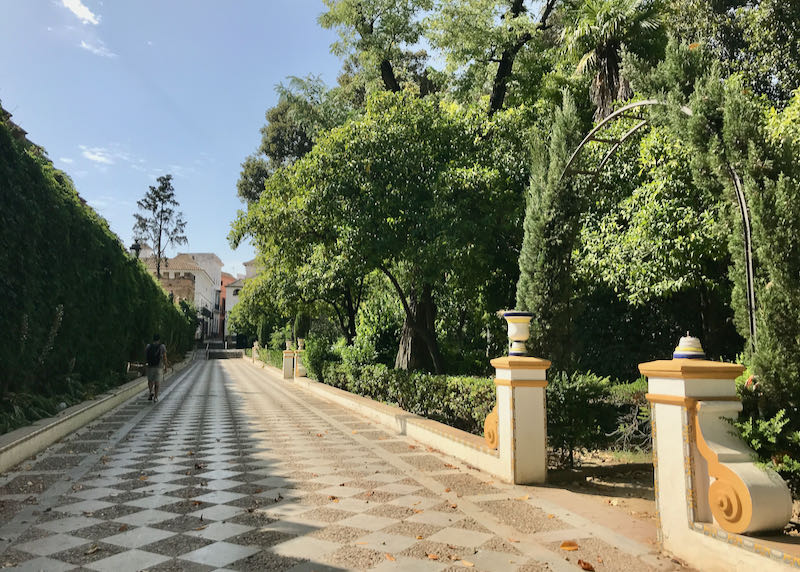
Take the path that cuts across the gardens to get to the Callejón del Agua, a narrow pedestrian lane that skirts the palace walls, and follow it left (west) as it winds it way back to the Plaza del Triunfo.
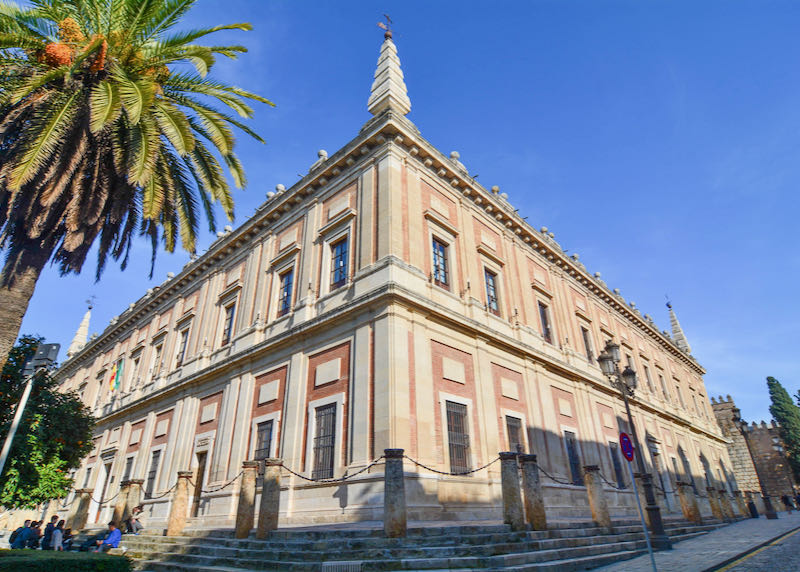
On the west side of the Plaza del Triunfo is the Archivo de Indias, the magnificent archive where hugely valuable historic documents regarding Spain’s conquest of the New World are kept.
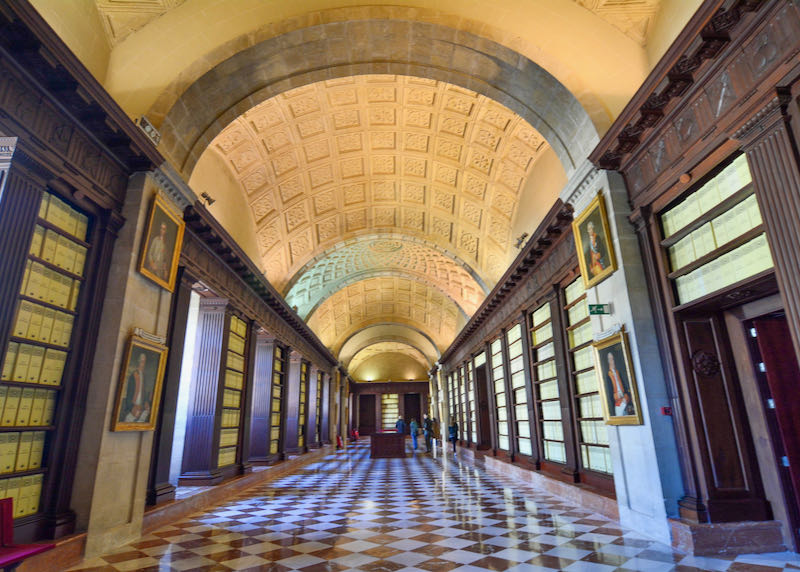
The vaulted galleries upstairs are well worth a look.
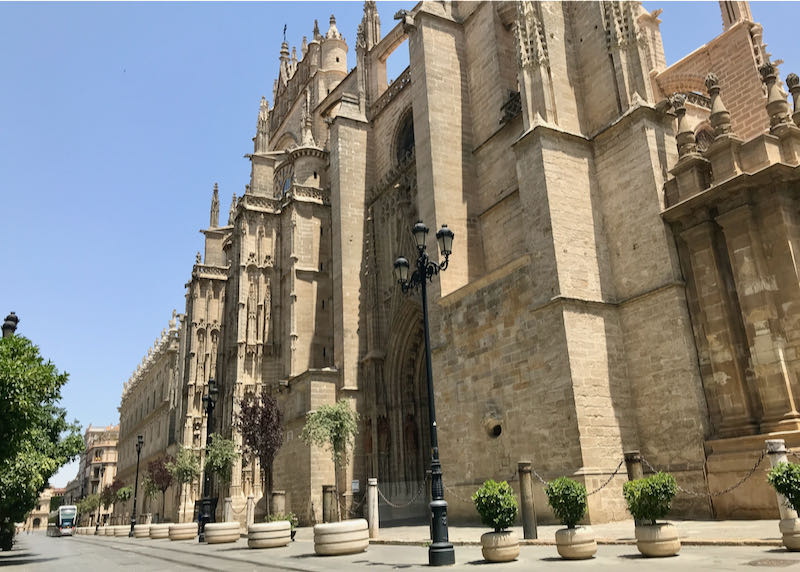
Just beyond is the Avenida de la Constitución, the main street with a tram line that runs north past the cathedral to Plaza Nueva.

Cross the avenue and then take the Calle Admiraltazgo and then Calle Dos de Mayo…
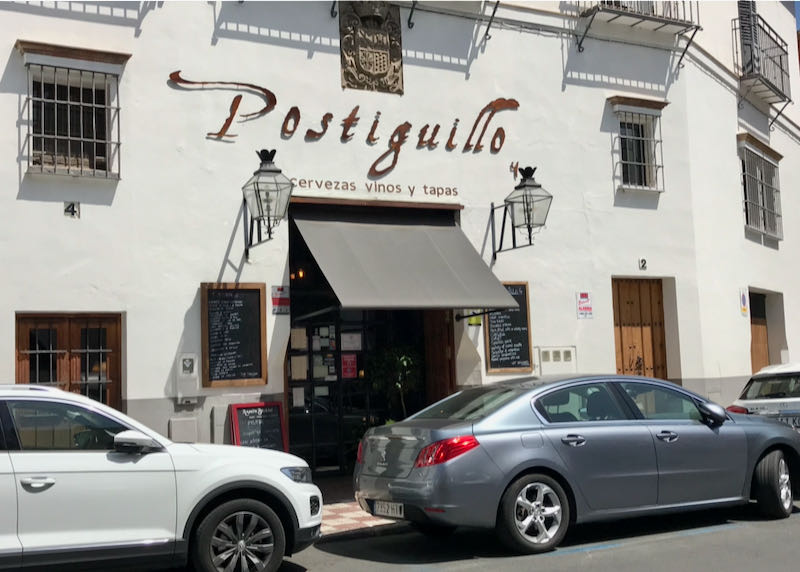
…to reach Bar Postiguillo, a corral-themed restaurant and tapas bar that serves meat-heavy Andalusian dishes.
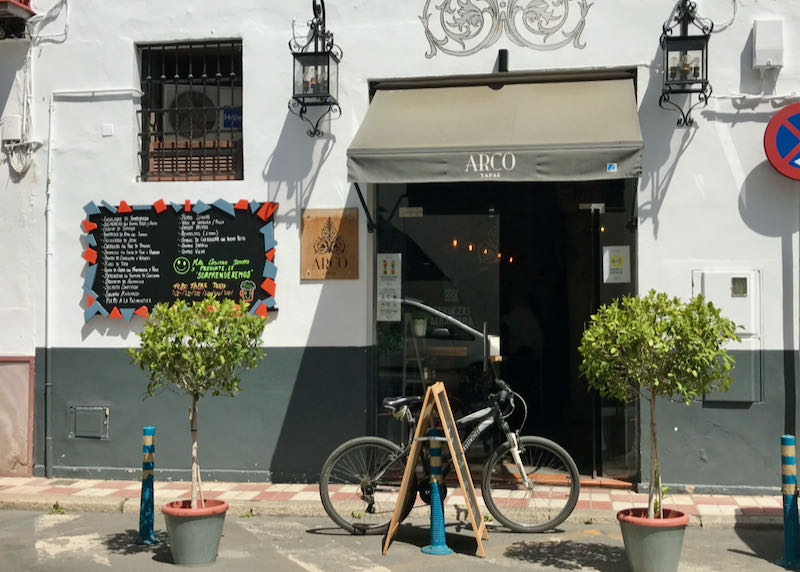
Nearby is Arco Tapas, a buzzy contemporary tapas bar specializing in international fare.
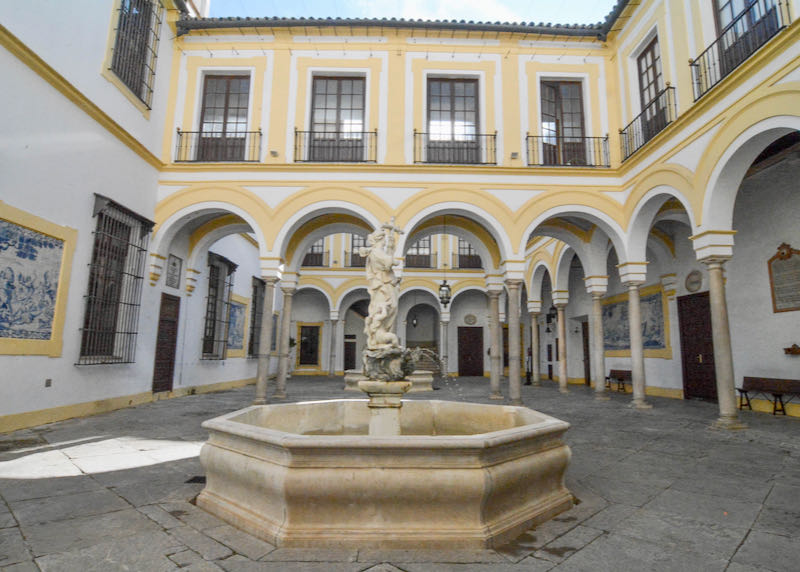
Half a block west and around the corner is the Hospital de la Caridad, a stunningly decorated 17th-century hospital for the poor.
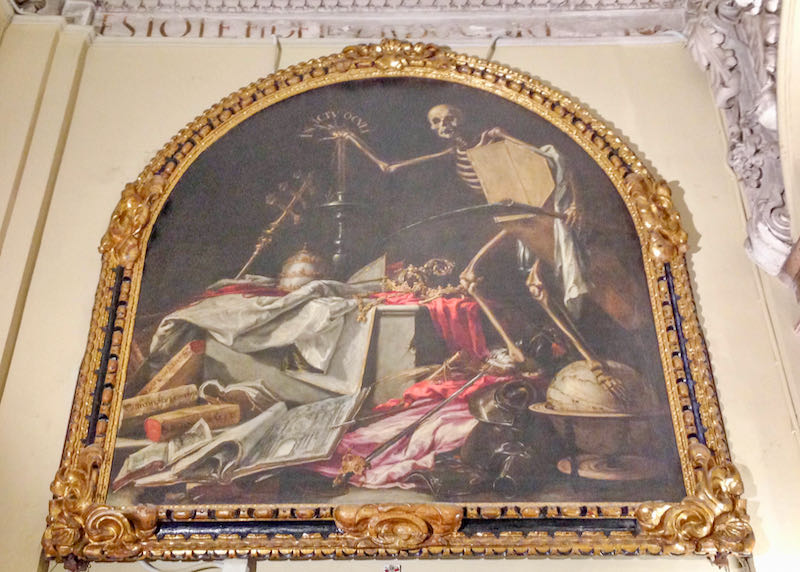
Don’t miss the Baroque chapel, decorated with powerful paintings on the theme of mortality by Valdés Leal.
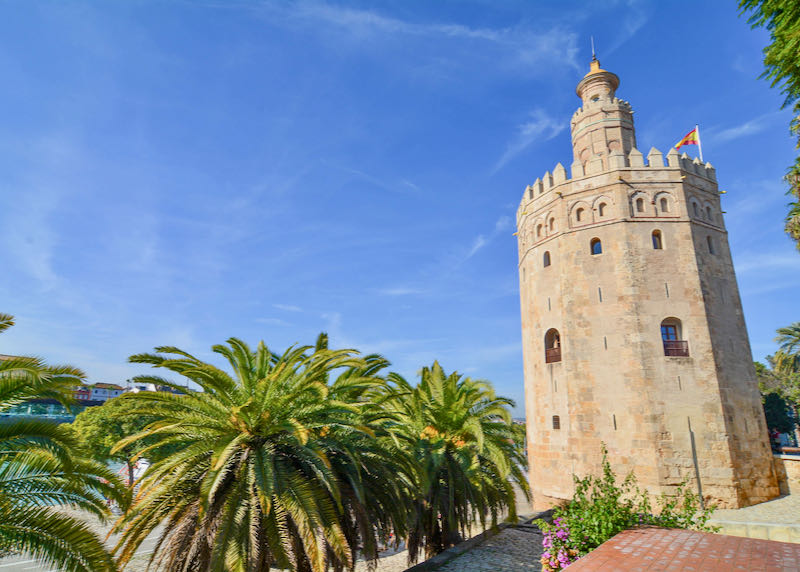
A block west is the river, and to its south is the naval museum inside the Torre de Oro.
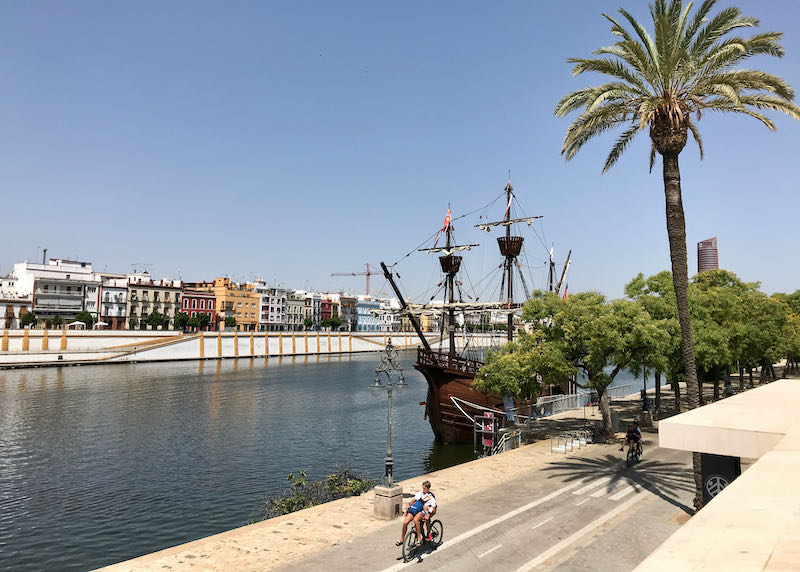
Or take the river promenade north…
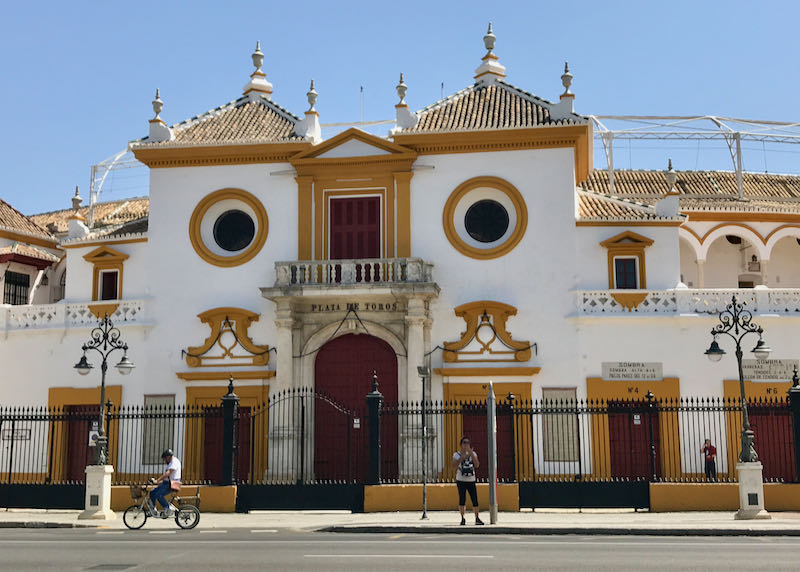
…till the Plaza de Toros La Maestranza, one of the oldest bullrings in Spain and still very much in use.
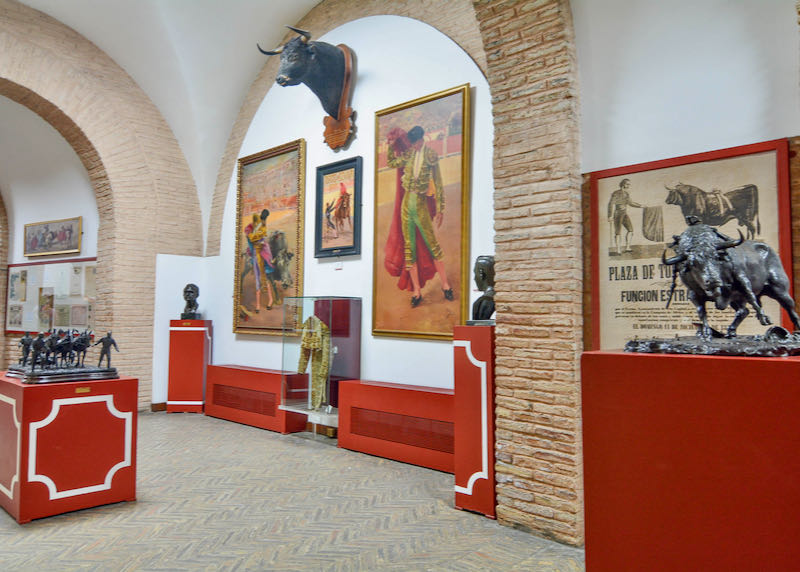
Even if not attending a bullfight, it’s well worth visiting the attached Museo Taurino to check out corrida-related art…
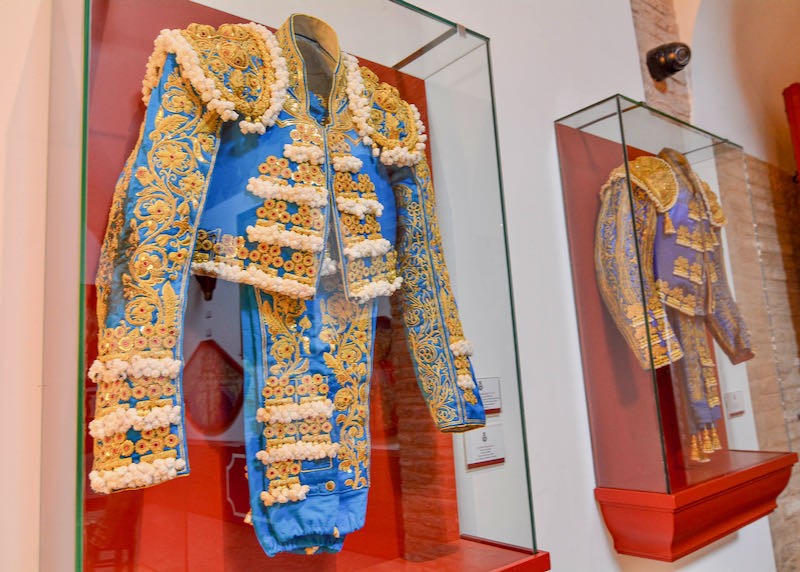
…and the trajes de luz (suits of light) worn by legendary matadors.
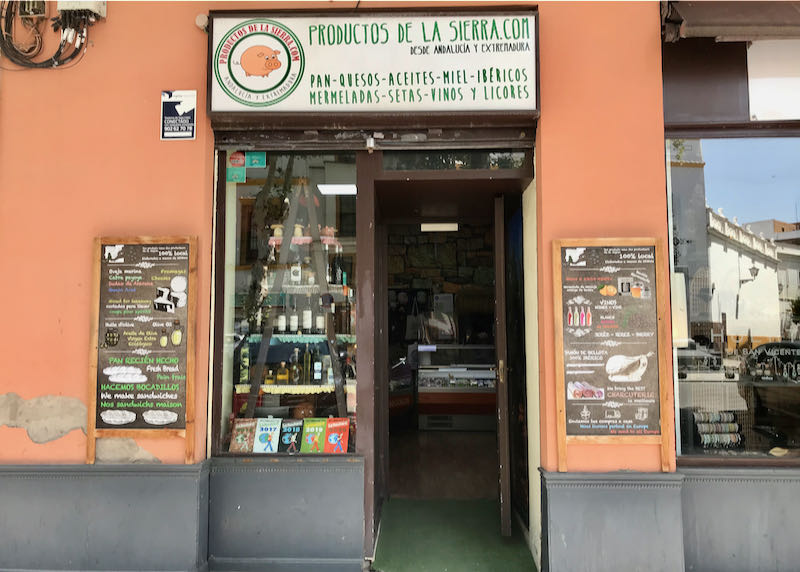
Just north of the bullring is Calle de Adriano and on it, Productos de la Sierra, a deli selling gourmet olive oils, charcuterie, and more.
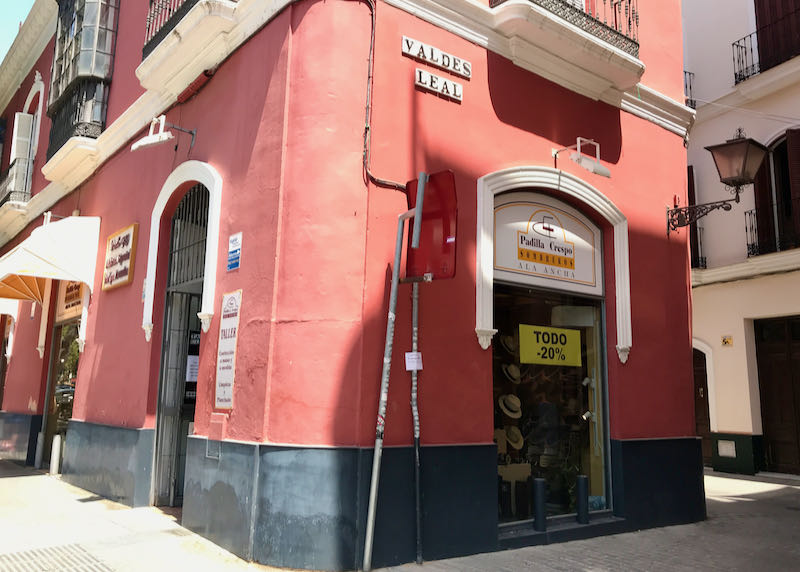
Nearby, Padilla Crespo Ala Ancha is the place to pick up espadrilles, hand-painted Andalusian fans, and locally made sombreros.
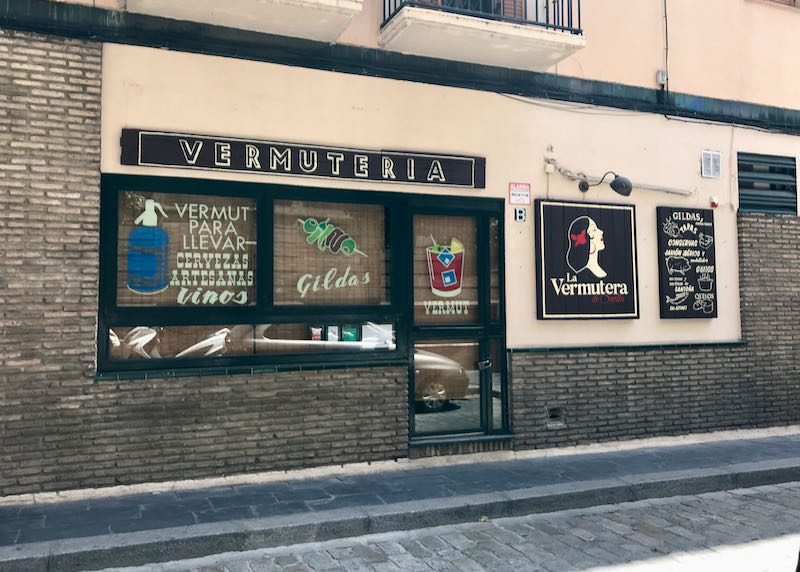
Around the corner, on Calle Castelar is La Vermutera de Sevilla, an old-school vermouth store and bar where one can try tipples from all over Spain.
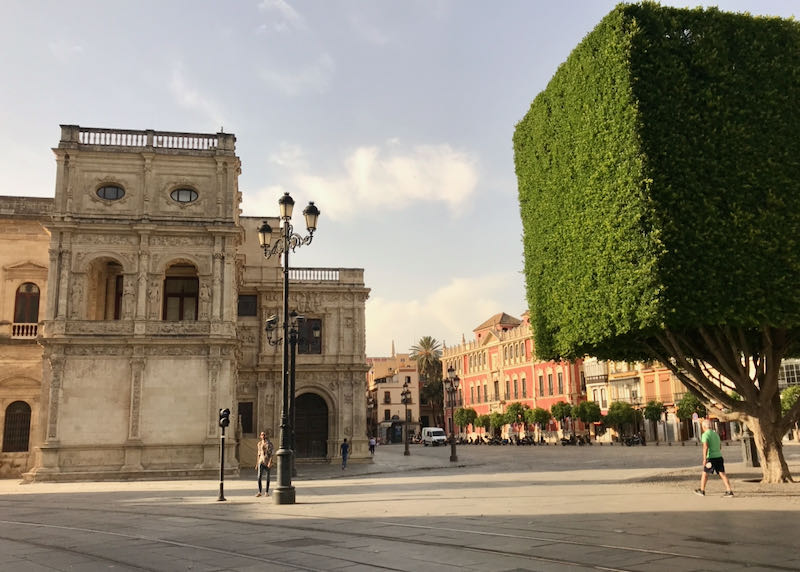
A couple of blocks north is the Plaza Nueva with its landscaped topiary.
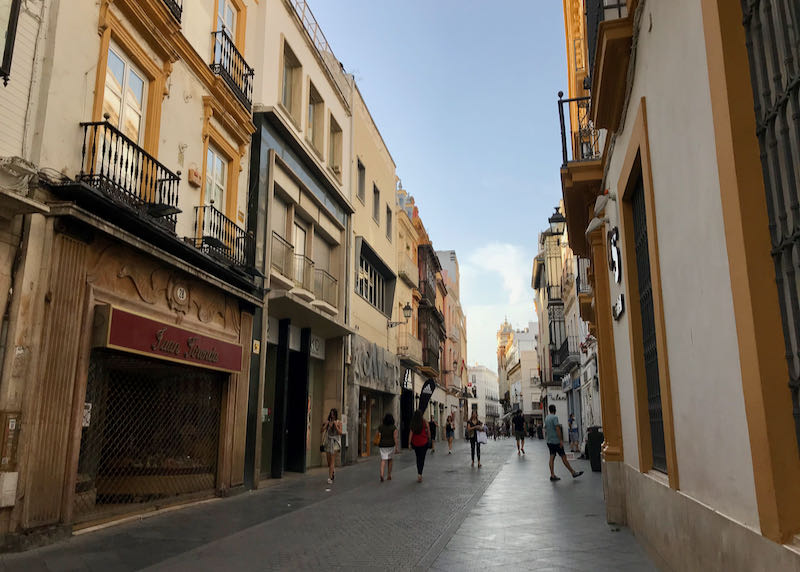
The pedestrian shopping street, Calle Sierpes, branches off from its northeast corner.
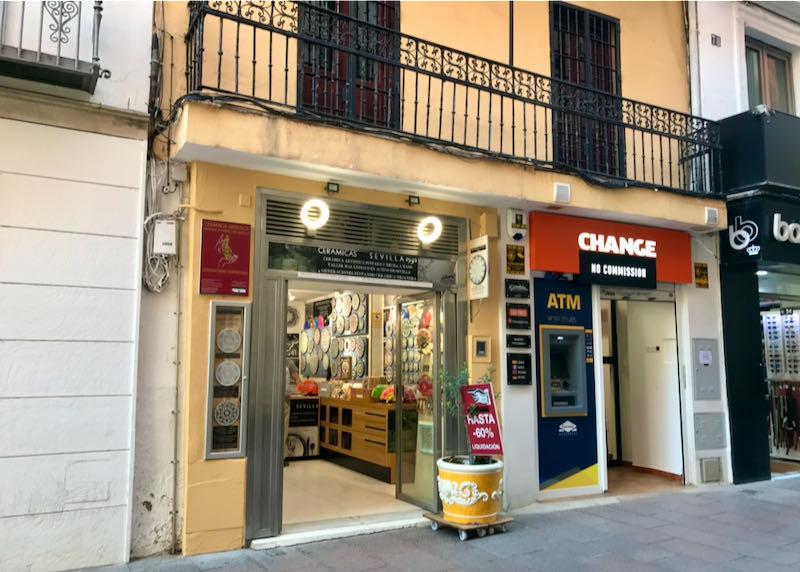
Ceramicas Sevilla 1952 sells colorful, locally made tiles and ceramic dishes.
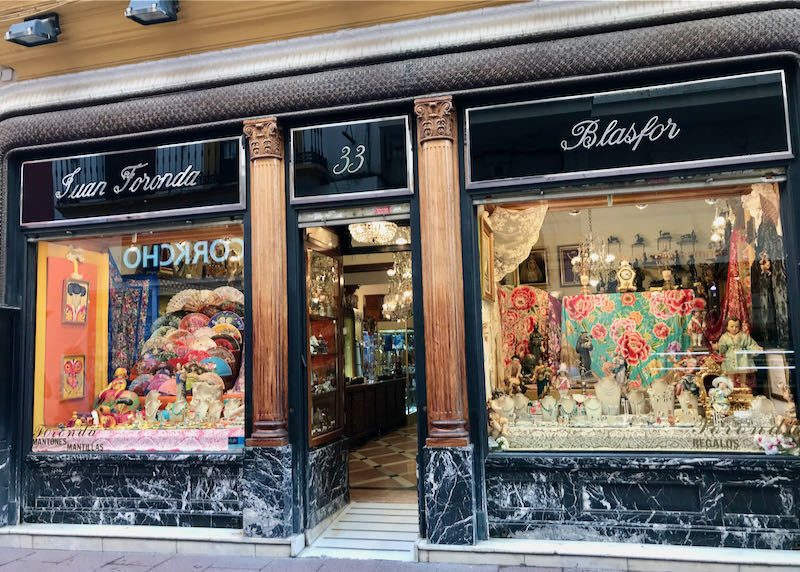
A little further along is Juan Foronda, a traditional store where one can buy hand-embroidered shawls, mantilla headdresses, fans, castanets, and other hand-crafted Andalusian accessories.
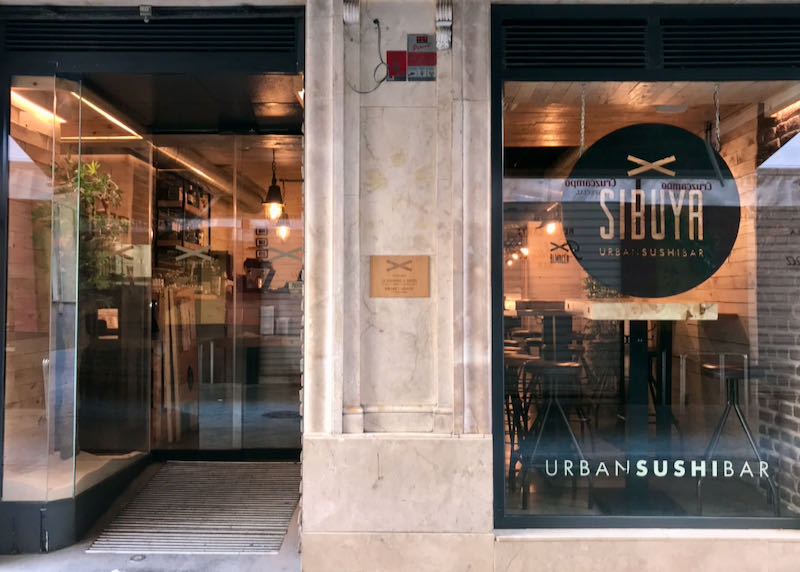
Around the corner, on Calle Albareda, is Sibuya, a minimalist sushi restaurant.
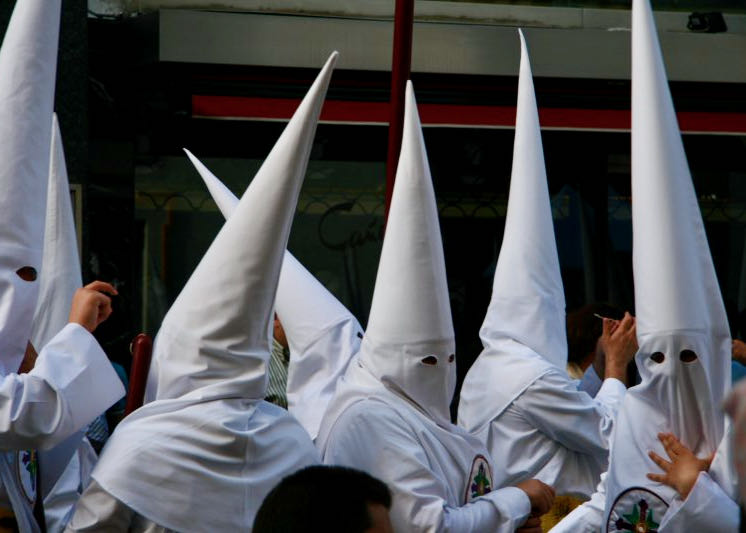
During Easter, Calle Sierpes and other streets in Seville’s historic center are roped off so that processions by the brotherhoods of different churches can take part.
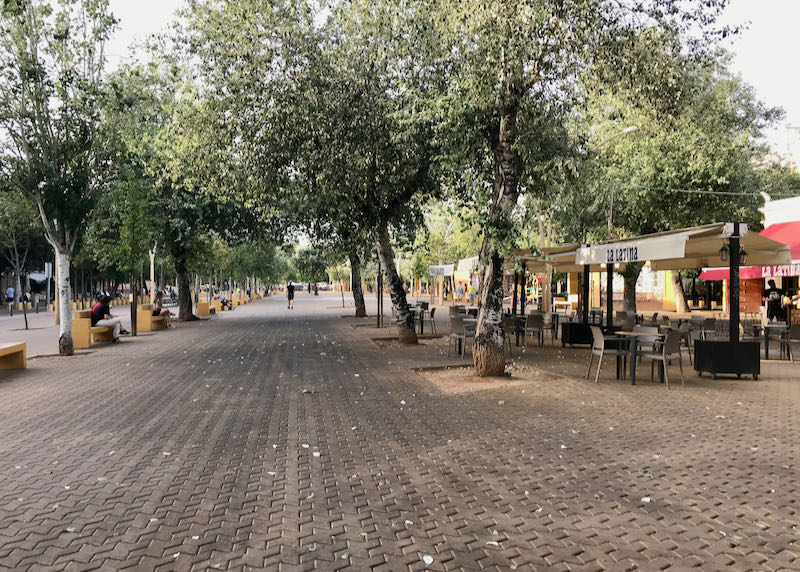
Following Calle Sierpes all the way north, and then continuing north along Calle Trojano for a few blocks leads to Alameda de Hercules, a long plaza lined with bars and restaurants.
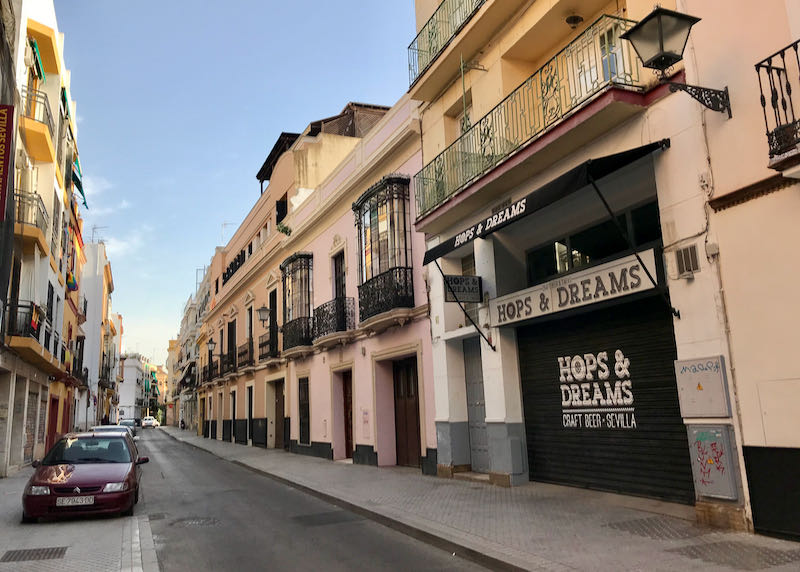
Some of Seville’s best craft beer is found here: there’s Hops & Dreams, on a street parallel to the square…

…and BierKraft, a couple of blocks east – an American-run, industrial chic beer bar. Check rates and availability: Casa 1800 Sevilla
Read More
- Seville Travel Guide
- Best Hotels in Seville
- Best Hotels for Families in Seville
- Best Boutique Hotels in Seville
- Where to Stay in Seville
- Best Things to Do in Seville
- Best Restaurants in Seville
- Best Hotels in Barcelona
- Best Boutique Hotels in Barcelona
- Best Hotels in Ibiza
- Best Hotels in Mallorca
- Madrid Travel Guide
- Best Hotels in Madrid
- Best Boutique Hotels in Madrid
About Santorini Dave